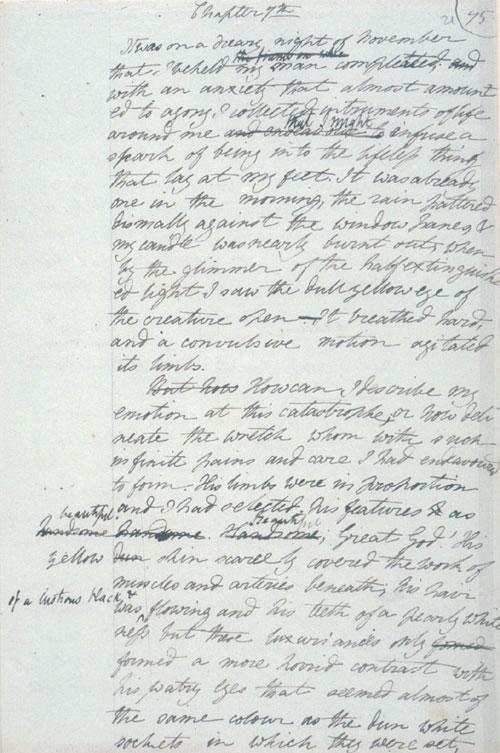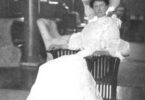
Mary Shelley and the Consequences of Creation
1816 was famously known as the ‘Year Without a Summer.’ Several climate abnormalities, including an enormous volcanic eruption, caused global temperatures to decrease. These low temperatures and subsequent heavy rains resulted in crop failures throughout Europe and the largest famine of the 19th century.
It was during this summer that a group of young Romantics were stuck inside their villa on Lake Geneva. Lord Byron was there, along with his physician John Polidori, friend Percy Shelley and his girlfriend Mary Godwin, and Mary’s step-sister Claire Clairmont, who was pursuing an ambivalent Bryon. They had fled to Switzerland on holiday to escape the crazy dysfunction they’d left behind in their ‘normal’ lives – but their love triangles make modern reality shows look downright puritanical!
Lord Byron had rented the private mansion, Villa Diodati, overlooking Lake Geneva, while Percy Shelley rented the smaller ‘Maison Chapuis’ nearby. The group spent the wet summer entertaining themselves indoors, reading from a French book of German ghost stories – Fantasmagoriana. Thoroughly chilled by the tales, Byron pronounced that they should write their own, opening up a contest amongst the young literary bunch.
The cast of characters:
Lord Byron:
At 28 years old, Lord Byron was already a literary celebrity after the publication of the first two cantos of Childe Harold’s Pilgrimage (1812). Byron inherited the title “Lord” in 1798 from his great-uncle. He was notorious for racking up debt and for numerous sex scandals – including reportedly getting his half-sister pregnant in 1814. On June 2nd, 1815, Byron married Annabella Milbanke, who was rumored to be the heiress of a rich uncle. Their only daughter, Ada, was born in December 1815. In January 1816 Annabella, calling Byron insane, left him, taking their daughter, and their separation was made legal in a private settlement in March 1816. Byron left England that April, never to return.
John Polidori:
20-year-old John Polidori was Lord Byron’s personal physician. The eldest son of an English mother and an Italian writer, he was sent to a Catholic boarding school at age eight, then to medical school at 15. After completing school at the age of 20 Polidori was too young to practice in London (you had to be 26 years old), so instead he took up as the personal physician of Lord Byron. He had always had literary interests and was drawn in by Byron’s charisma and celebrity.
Mary Shelley:
Mary Shelley was 18 years old in the summer of 1816. Two years earlier she had met Percy Bysshe Shelley, the poet and philosopher. Mary’s father, William Godwin, was something of a mentor to the young (married) Shelley, who in turn offered Godwin financial assistance. Mary and Percy fell in love, often meeting secretly at her mother’s grave in the churchyard. It is rumored she lost her virginity to him in the same cemetery. On July 28th, 1814 the couple eloped and left for France with her French-speaking step-sister Claire, leaving Percy’s pregnant wife Harriet behind. On November 30th, 1814 Harriet Shelley gave birth to a son, Charles. On February 22, 1815, Mary Godwin gave birth to a premature baby girl who died six weeks later. Although troubled and depressed by the birth of the baby, Mary again became pregnant and on January 24, 1816, she gave birth to another baby, a son named William. During the summer of 1816, Percy was still married to Harriet.
Percy Bysshe Shelley:
One of the major English Romantic poets, Percy Bysshe Shelley was 23 years old in the summer of 1816. In 1811 Shelley eloped with 16-year-old Harriet Westbrook. In July 1814 Shelley abandoned Harriet and ran away with Mary Godwin, daughter of his mentor William Godwin, and her stepsister Claire Clairmont, to Switzerland. Although the trio eventually returned to England, destitute, and attempted to make amends with the furious William Godwin. They didn’t stay long, before running away again to France and Switzerland.
Claire Clairmont:
At 18 years old, Claire was just slightly younger than her step-sister Mary. Earlier in the year, Claire had an affair with Byron and she continued to pursue him, although he made it clear there was not a future between them. It was Claire’s idea to visit Byron in Geneva, and she brought her usual travel mates, her step-sister Mary and Percy Bysshe Shelley along. Claire was the daughter of William Godwin’s second wife, Mary Jane Vial Clairemont, and her lover Sir John Lethbridge. Claire’s mother’s dislike of Mary didn’t dissuade them from a close friendship. She was educated and fluent in French, which Mary and Percy found useful on their travels. Claire had a close relationship with the Shelley’s and was rumored to have had a child by Percy. She was with the couple when they eloped and lived with them throughout most of their marriage.
Frankenstein; or, The Modern Prometheus

At first, Mary had trouble coming up with a story to chill her comrades at the villa. However, one sleepless night the story of Dr. Frankenstein and his creation came to her in a ‘waking dream’. Manuscripts and diaries from the time show that Percy Shelley was involved with editing the manuscript as well, which grew from a short story to a full novel. In early summer 1817, Mary finished her novel.
In the book, the title character of Frankenstein is not the monster, but rather the creator. At first, the creature he creates is grotesque but gentle and intelligent – only becoming destructive and brutal when he’s discarded because of his appearance and rejected in his search for companionship.
Mary herself was rejected by her family, just as Frankenstein’s creature was rejected by his creator. Her mother Mary Wollstonecraft died in 1797 from complications after Mary’s birth. Mary Wollstonecraft had been an outspoken advocate for women’s rights at a time when they had nearly none. She penned A Vindication of the Rights of Woman in 1792, and her daughter Mary later read the book with Percy and Claire during their travels. After his wife’s death, William Godwin remarried, and his new wife did not favor her step-daughter, to say the least.
Frankenstein was published anonymously on January 1st, 1818 when Mary Shelley was just 20 years old. The second edition of Frankenstein, published in 1823, bore the author’s name as Mary Shelley.
More haunting tales…
Another eerie creature was birthed on that fateful night as well. Polidori, Byron’s physician, wrote The Vampyre, which would become the first published story featuring a vampire. Based on a creature from European folklore, Polidori’s blood-sucking aristocrat was most likely modeled on Byron himself and became the standard by which other literary vampires took shape. On April 1, 1819, New Monthly Magazine published Polidori’s tale. It was, however, falsely attributed to Lord Byron.
After the summer was over…
Unfortunately, the young Romantics’ ideology of free love and unfettered living created a path of destruction not unlike the brutal creation of the mad scientist Frankenstein.
On December 10th, 1816 the body of Shelley’s wife Harriet was found drowned in Hyde Park in London. She was very pregnant, most likely from a lover taken after Percy had left her. Three weeks after her death, Percy and Mary were married.
By the age of 21, Mary Shelley had become a wife, a mother, and a novelist. By the age of 24, she was a widow as well. Percy Bysshe Shelley died on July 8, 1822, drowning when his boat was caught in a storm. His body was found ten days after the accident and cremated. Legend has it that his heart refused to burn and was taken from the funeral fire by poet Leigh Hunt. It was eventually turned over to Mary and later found in her desk a year after her own death, wrapped in a silk shroud with a copy of one of Percy’s last poems – Adonais. In 1889 it was buried in the family vault with the only one of the couple’s four children to survive into adulthood – Percy Florence Shelley. Mary Godwin Shelley died in 1851, at age 53 from a brain tumor.
John Polidori died August 24, 1821, of suicide by cyanide. He was just 25 years old.
In January 1817, Claire Clairmont gave birth to Lord Byron’s daughter, who interestingly Percy Shelley made provisions for in his will. Claire followed Byron to Italy after the birth of Alba, later renamed Allegra, but Byron only agreed to take their daughter in if Claire agreed to stay away. Claire reluctantly left her daughter with Byron, who soon sent the child to live in a convent where she died at age five from fever.
Lord Byron died of fever on April 19, 1824, at the age of 36 while fighting the Ottoman Empire during the Greek War of Independence.
Claire Clairmont was the last of the group to pass, dying March 19, 1879, at the age of 80. She had converted to Catholicism and wrote a scathing memoir of Byron and Shelley, discussing the harm of their free love ideology, especially on women. This lost memoir was found in the Shelley papers in the New York Public Library by researcher Daisy Hay, who later published a novel about the poets titled: Young Romantics: The Tangled Lives of English Poetry’s Greatest Generation.
References:
The Poet and The Vampyre: The Curse of Byron and the Birth of Literature’s Greatest Monsters (2014) by Andrew McConnell Stott.
Young Romantics: The Tangled Lives of English Poetry’s Greatest Generation (2010) by Daisy Hay.
Amy C. Manikowski is a writer living in Asheville, NC.









Thank you for the snippet on how Frankenstein was born
Thank you Amy for this interesting and entertaining piece. Mary Shelley’s Frankenstein was one of the first Books I bought at My schools “BOOKMOBILE” back in 1973 when I was a Boy. It was a small Paperback with a picture of Boris Karloff in Character on the cover…..I loved the movie 1931 Frankenstein so at 8 years old I grabbed up the Book!!
This is certainly an interesting and entertaining snippet of literary history. I think THIS story would make a fascinating book or movie. Nice job! Thanks.
This is certainly an interesting and entertaining snippet of literary history.
I think THIS story would make a fascinating book or movie. Nice job! Thanks.